by Martin Maisel
(photos used with appropriate permission)
In the early years of the 20th century aviation was a novelty. Commercial uses were slow to develop and U.S. military leaders generally did not
recognize the potential utility of air power and, therefore, devoted very meager resources to their aviation assets. After World War I, trained pilots, released from the military services due to budget cuts, took to “barnstorming” in surplus trainers to make a few bucks and to expose and thrill America with the new wonder of manned flight. The notion of flying began to take hold.
By the 1920s, in hopes of feeding the growing public interest in aviation, many companies were established to develop and build light aircraft for
“general aviation” use. Most did not succeed and eventually faded into oblivion. A few individuals, however, planted the seeds that would grow into the light aircraft industry in America. Their story is told here.
Part I
Clyde Cessna
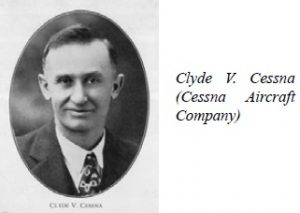 Clyde V. Cessna was born in 1879 in Iowa and his family moved to Rago, Kansas, when he was two years old. Clyde grew up on a farm and found that, with his self-taught mechanical skills, he could make significant improvements to farm machinery and food processing methods. His penchant for mechanical things led to his interest in the evolving automobile industry.
Clyde V. Cessna was born in 1879 in Iowa and his family moved to Rago, Kansas, when he was two years old. Clyde grew up on a farm and found that, with his self-taught mechanical skills, he could make significant improvements to farm machinery and food processing methods. His penchant for mechanical things led to his interest in the evolving automobile industry.
After owning one of the first horseless carriages in the area, he became an automobile mechanic and salesman and, in time, operated the successful Overland Automobile Agency in Enid, Oklahoma.
In 1910 Cessna saw his first airplane when the Moisant International Aviators, a travelling flying circus, put on a flight demonstration in Oklahoma City. He was so inspired by aviation that he gave up his job and moved to New York to work for the Queen Aeroplane Company to learn about aircraft construction.
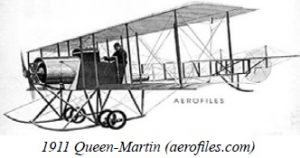 In 1911 Cessna purchased a fuselage from Queen and moved back to Oklahoma to build his own airplane, the “Silverwing”-a monoplane resembling the French Bleriot design. The powerplant for the Silverwing was a 40 HP Elbridge marine engine that Cessna converted for aircraft use.
In 1911 Cessna purchased a fuselage from Queen and moved back to Oklahoma to build his own airplane, the “Silverwing”-a monoplane resembling the French Bleriot design. The powerplant for the Silverwing was a 40 HP Elbridge marine engine that Cessna converted for aircraft use.
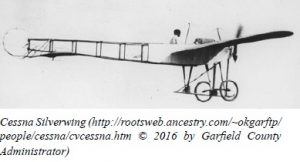 Clyde Cessna’s flight training proved to demonstrate his determination to be an aviator. With no means of obtaining flight instruction, Cessna set out to learn to fly by himself in his own airplane. Predictably, this resulted in numerous crashes (13 or 14 according to various reports), and led to an “extended hospital stay” on at least one occasion. Undaunted, Cessna eventually succeeded in June 1911, but realized that his initial design did not fly well. In the next few years, during the cold Midwest winters, he built additional monoplanes with the continuing goal of improving the structure, performance, and flying qualities of his airplanes.
Clyde Cessna’s flight training proved to demonstrate his determination to be an aviator. With no means of obtaining flight instruction, Cessna set out to learn to fly by himself in his own airplane. Predictably, this resulted in numerous crashes (13 or 14 according to various reports), and led to an “extended hospital stay” on at least one occasion. Undaunted, Cessna eventually succeeded in June 1911, but realized that his initial design did not fly well. In the next few years, during the cold Midwest winters, he built additional monoplanes with the continuing goal of improving the structure, performance, and flying qualities of his airplanes.
Cessna’s interest in aviation went beyond the aesthetics of flight. He recognized that flight demonstrations could be a lucrative enterprise. In
1915, in Wichita, he conducted an aerial extravaganza that drew huge crowds. He moved his manufacturing operations to the Jones Motor Car plant in Wichita in 1916 and built four monoplanes that he intended to use for flight training and exhibitions. In gratitude for the use of the factory, Cessna painted “Jones Six” on the wings of his first plane-most likely the first aircraft to display an advertisement for an automobile. His next plane, called the Comet, had a partially enclosed cockpit and was used for over thirty exhibitions attended by thousands of thrill seekers at state fairs and other public events throughout the Midwest and southeastern states.
 The entry of the United States in World War I in April 1917 put an end to the successful Cessna Exhibition Company business, and he returned to his Rago, Kansas, farm to produce wheat for the war effort.
The entry of the United States in World War I in April 1917 put an end to the successful Cessna Exhibition Company business, and he returned to his Rago, Kansas, farm to produce wheat for the war effort.
While no longer in the aircraft building and exhibition business, Cessna maintained an interest in flying and was reported to have purchased a Laird Swallow in 1924, the only biplane he ever owned.
 E. M. “Matty” Laird had partnered with the founders of the Wichita Airplane Company in 1920 to build the Swallow biplane by the new company that bore his name. Due to difficulties with partner and financier J. M. “Jake” Mollendick, Laird left the company and sold all his rights to the company to Mollendick. Under Mollendick the company was renamed the Swallow Airplane Company and continued to produce the Swallow. It is interesting to note that another employee of the Swallow Company, George “Buck” Weaver, who is credited with the original design of the Swallow airplane, resigned soon after Laird departed because of his differences with Mollendick. Weaver then founded the Weaver Airplane Company, soon enough to be known as WACO.
E. M. “Matty” Laird had partnered with the founders of the Wichita Airplane Company in 1920 to build the Swallow biplane by the new company that bore his name. Due to difficulties with partner and financier J. M. “Jake” Mollendick, Laird left the company and sold all his rights to the company to Mollendick. Under Mollendick the company was renamed the Swallow Airplane Company and continued to produce the Swallow. It is interesting to note that another employee of the Swallow Company, George “Buck” Weaver, who is credited with the original design of the Swallow airplane, resigned soon after Laird departed because of his differences with Mollendick. Weaver then founded the Weaver Airplane Company, soon enough to be known as WACO.
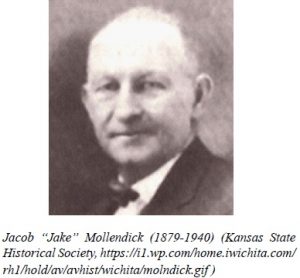 Two young employees of the Swallow company, Walter Beech and Lloyd Stearman, proposed significant structural design changes to improve the aircraft but Mollendick, enraged by their proposal, invited them to take their proposal, and employment elsewhere. By the end of 1924 Beech and Stearman left cantankerous Mollendick and started a new aircraft company. Needing financing and an experienced business leader, they contacted Clyde Cessna. Cessna accepted the position of president of the newly founded Travel Air Manufacturing Company. Walter Beech served as vice president and Lloyd Stearman as chief engineer. In 1925, Travel Air set up shop in a factory in downtown Wichita. Cessna provided the woodworking tools, Stearman was the principal designer, and Beech managed the assembly line.
Two young employees of the Swallow company, Walter Beech and Lloyd Stearman, proposed significant structural design changes to improve the aircraft but Mollendick, enraged by their proposal, invited them to take their proposal, and employment elsewhere. By the end of 1924 Beech and Stearman left cantankerous Mollendick and started a new aircraft company. Needing financing and an experienced business leader, they contacted Clyde Cessna. Cessna accepted the position of president of the newly founded Travel Air Manufacturing Company. Walter Beech served as vice president and Lloyd Stearman as chief engineer. In 1925, Travel Air set up shop in a factory in downtown Wichita. Cessna provided the woodworking tools, Stearman was the principal designer, and Beech managed the assembly line.
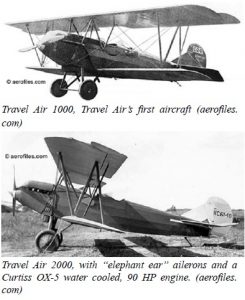 The first products of the new company were biplanes. The Model 2000 and its improved and higher-powered successors, the Travel Air 3000 and 4000 sold well and enabled the company to move to larger facilities.
The first products of the new company were biplanes. The Model 2000 and its improved and higher-powered successors, the Travel Air 3000 and 4000 sold well and enabled the company to move to larger facilities.
However, Cessna was a strong advocate of the monoplane and, unable to convince his partners that there would be a large market for that type, he
rented a shop in 1926 and built a monoplane himself. That aircraft not only convinced his associates of its appeal, but caught the attention of the National Air Transport company, one of the nations first airlines, which was seeking a plane to carry mail and passengers. A fleet of the high-wing, enclosed-cabin, strut-braced, four-place monoplanes, designated the Travel Air 5000, was ordered by the National Air Transport company, further establishing Travel Air as a major aircraft manufacturer. Orders from other airlines soon followed.
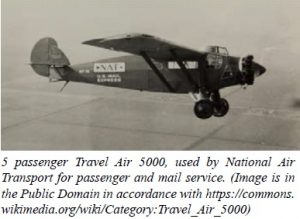 Travel Air monoplanes, providing significant speed and range advantages over many aircraft of the time, set several historic records and won the challenging California to Hawaii Dole Air Derby in August 1927.
Travel Air monoplanes, providing significant speed and range advantages over many aircraft of the time, set several historic records and won the challenging California to Hawaii Dole Air Derby in August 1927.
Cessna believed that the performance of the monoplane could be further improved by eliminating the wing struts. To his dismay, his proposal was dismissed as folly by his Travel Air associates. Upset with their lack of foresight, Cessna sold his stock, resigned from Travel Air under amicable terms and formed the Cessna Aircraft Company in January 1927.
 The product of Clyde’s fully cantilevered monoplane was the Cessna Model A. To verify the wing’s strength, he proof-loaded it to twice the aircraft’s weight (i.e. 2g) and to impress safety-minded potential buyers, he photographed the aircraft with 17 men standing on the wing. The marketing plan worked and production started in 1928. Five different engines were available to the buyers. One variant soon earned nationwide publicity by winning the 1928 Transcontinental Air Derby and the 50-mile closed circuit event at the National Air Races. By the end of 1928 business was booming.
The product of Clyde’s fully cantilevered monoplane was the Cessna Model A. To verify the wing’s strength, he proof-loaded it to twice the aircraft’s weight (i.e. 2g) and to impress safety-minded potential buyers, he photographed the aircraft with 17 men standing on the wing. The marketing plan worked and production started in 1928. Five different engines were available to the buyers. One variant soon earned nationwide publicity by winning the 1928 Transcontinental Air Derby and the 50-mile closed circuit event at the National Air Races. By the end of 1928 business was booming.
During that time, Cessna, now joined by his engineer son Eldon, developed improved versions of his monoplane as well as other aircraft specifically
designed for air racing, a popular spectator sport that offered significant prize money to the winners.
 Then, on October 29, 1929, the stock market crashed. Aircraft sales plummeted and, facing bankruptcy, the board of directors of the Cessna Aircraft Company ceased operations in 1931. After failing to keep the company afloat building general aviation and transport aircraft, Cessna and his son formed another company to build specialty aircraft-primarily racers. The C.V. Cessna Aircraft Company’s first production design, a mid-wing monoplane designated the CR-2, captured fourth place in the 1930 National Air Race event. A second Cessna racer built for the Nationals took two second place and one third place in men’s races and won a second place finish in the women’s event.
Then, on October 29, 1929, the stock market crashed. Aircraft sales plummeted and, facing bankruptcy, the board of directors of the Cessna Aircraft Company ceased operations in 1931. After failing to keep the company afloat building general aviation and transport aircraft, Cessna and his son formed another company to build specialty aircraft-primarily racers. The C.V. Cessna Aircraft Company’s first production design, a mid-wing monoplane designated the CR-2, captured fourth place in the 1930 National Air Race event. A second Cessna racer built for the Nationals took two second place and one third place in men’s races and won a second place finish in the women’s event.
CR-2s continued to place first or second in the 1932 and 1933 air races but then tragedy struck. Cessna’s close friend, Roy Ligget, was killed in the
crash of a CR-2 built by Clyde and Eldon. While in a high speed flight the engine cowling failed and struck the wing hard enough to tear it off, flinging the plane to the ground in front of Clyde. Clyde Cessna, deeply affected by the loss of his friend, withdrew from aviation and returned to his farm.
The Cessna Airplane Company, shuttered in 1931, remained dormant until 1934 when two of Clyde Cessna’s nephews garnered Cessna Aircraft’s main stockholders support to regain control of the defunct organization. One of the nephews was Dwane Wallace, a young aeronautical engineer who was the first person to receive an aeronautical engineering degree from the Municipal University of Wichita. His brother, Dwight Wallace, was an attorney, who handled the business arrangements. Clyde was reinstated as president but it was Dwane who guided the company back to solvency.
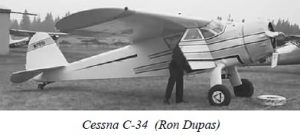 Under Dwane Wallace’s leadership and engineering expertise, the company developed the C-34 Airmaster. Regarded by some as a masterpiece of design, the C-34 sales were sufficient, in spite of the difficult economic times, to soon allow the company to be profitable again. The highly efficient C-34 and its successive variants became the economic backbone of the reconstituted company. Dwane Wallace’s gamble had paid off.
Under Dwane Wallace’s leadership and engineering expertise, the company developed the C-34 Airmaster. Regarded by some as a masterpiece of design, the C-34 sales were sufficient, in spite of the difficult economic times, to soon allow the company to be profitable again. The highly efficient C-34 and its successive variants became the economic backbone of the reconstituted company. Dwane Wallace’s gamble had paid off.
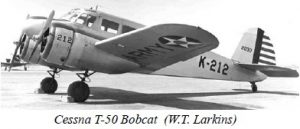 With adequate resources to invest in new products, Wallace set his sights on a wood-and-metal twin-engine aircraft that was designated as the T-50 Bobcat. Not only did Wallace participate in the design, he served as its test pilot, thus becoming the Cessna company’s first multi-engine pilot.
With adequate resources to invest in new products, Wallace set his sights on a wood-and-metal twin-engine aircraft that was designated as the T-50 Bobcat. Not only did Wallace participate in the design, he served as its test pilot, thus becoming the Cessna company’s first multi-engine pilot.
By the end of the 1930s the approaching war in Europe and Asia fed the American aircraft industry with orders for various types of airplanes. The
Cessna T-50 would become a light transport or a multi-engine trainer for American, Canadian and British military services, in addition to other foreign users.
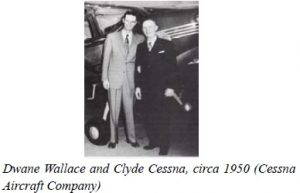 Clyde Cessna, however, did not play a significant role in the resurrection of the company that he founded. He had resigned from Cessna Aircraft in 1936 and returned to his farm. From that time on, his involvement was only “ceremonial.”
Clyde Cessna, however, did not play a significant role in the resurrection of the company that he founded. He had resigned from Cessna Aircraft in 1936 and returned to his farm. From that time on, his involvement was only “ceremonial.”
Clyde Cessna died in November 1954-nearly two decades after he walked away from the aircraft industry.
With only a rudimentary formal education he made significant contributions to the developing American aviation industry in the early part of the
twentieth century.
Cessna was inducted into the National Aviation Hall of Fame in 1978 and the International Aerospace Hall of Fame in 1983.
Clyde Cessna never bothered to obtain a pilot license.
